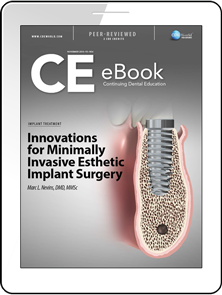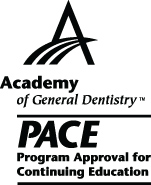CDEWorld > eBooks > Innovations for Minimally Invasive Esthetic Implant Surgery


ADA CERP is a service of the American Dental Association to assist dental professionals in identifying quality providers of continuing dental education. ADA CERP does not approve or endorse individual courses or instructors, nor does it imply acceptance of credit house by boards of dentistry. Concerns or complaints about a CE provider may be directed to the provider or to ADA CERP at www.ada.org/cerp/

Approved PACE Program Provider. FAGD/MAGD credit. Approval does not imply acceptance by a state or provincial board of dentistry, or AGD endorsement. 1/1/2023 to 12/31/2028. ID # 209722.
eBook
Released: Monday, November 21, 2016
Expires: Saturday, November 30, 2019
Innovations for Minimally Invasive Esthetic Implant Surgery
By Marc L. Nevins, DMD, MMSc
Commercial Supporter: OsteoHealth
The use of growth factor technology and advances in minimally invasive surgical techniques have enabled dentists to modify the manner in which they approach and sequence cases requiring extractions, implant placement, and/or corrective bone and soft-tissue preservation and/or augmentation. Simultaneously, these innovations have contributed to greater predictability in the outcomes that can be achieved for esthetic dental implant cases. This article provides an overview of how flapless extraction, bone/soft-tissue grafting, implant placement techniques, ridge volume preservation and augmentation procedures, and growth factor/biologic materials can be incorporated to provide an overall minimally invasive approach to esthetic implant treatments.
LEARNING OBJECTIVES:
-
Identify considerations for flapless extraction and bone/soft-tissue grafting techniques.
-
Discuss the differences between ridge volume preservation versus augmentation.
-
Explain the benefits of growth factors/biologics for bone and soft-tissue grafting.
-
Describe different approaches for sequencing necessary procedures to ensure predictable esthetic outcomes for dental implant treatments.
About the Author
Marc L. Nevins, DMD, MMSc
Private Practice, Boston Periodontics & Dental Implants, Boston, Massachusetts


